Caddisfly Larva
Scientific Name: Trichoptera (larva)
Order & Family: Order: Trichoptera; Family: Varies widely, as there are many families within Trichoptera.
Size: Larvae typically range from a few millimeters to 2-3 cm (0.1 to 1.2 inches) in length, depending on the species.

Natural Habitat
Found in various freshwater aquatic environments, including streams, rivers, lakes, and ponds. The type of case material often indicates the specific microhabitat.
Diet & Feeding
Depending on the species, caddisfly larvae can be detritivores (eating decaying plant matter), herbivores (grazing on algae and aquatic plants), predators (eating smaller invertebrates), or omnivores.
Behavior Patterns
Larvae construct portable cases from silk and various materials like sand, small stones, or plant fragments. They use these cases for protection and camouflage. Adults are typically short-lived and do not feed, focusing solely on reproduction. The larvae are aquatic.
Risks & Benefits
Benefits: Caddisfly larvae are important indicators of water quality; their presence often signifies healthy aquatic ecosystems. They are also a significant food source for fish and other aquatic animals. Risks: Generally no direct risks to humans.
Identified on: 9/3/2025